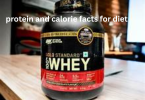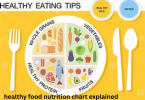Have you ever picked up a cereal box, energy bar, or even a jar of peanut butter and stared at the back, wondering what all those numbers and terms mean? If so, you’re not alone. Understanding nutrition labels easily is a skill that can make a huge difference in your health, weight management, and even your energy levels. Let’s break it down in a simple, friendly way, step by step.
Why Nutrition Labels Are Important

Nutrition labels are essentially a map of what’s inside your food. They tell you not just calories, but also protein, fats, sugar, sodium, vitamins, and more. By understanding them, you can:
- Make healthier food choices
- Avoid hidden sugars, fats, and sodium
- Control portion sizes and calorie intake
- Track nutrients that affect your health goals
- Understand the difference between nutrient-rich foods and empty-calorie foods
In short, reading nutrition labels is like having a superpower—it helps you make smarter decisions without guessing.
Step 1: Start With Serving Size
The first thing to notice is the serving size. This is the foundation for the rest of the numbers on the label. Everything else—calories, fats, sugars, and nutrients—is based on this serving size.
Tip: If you eat more than one serving, multiply all the numbers by the number of servings you actually eat.
Example:
- Serving Size: 1 bar
- Calories per serving: 200
- You eat 2 bars → 400 calories consumed
Understanding serving sizes is crucial because it’s the most common mistake people make when interpreting labels.
Step 2: Calories—Energy in a Number
Calories tell you how much energy the food provides.
- 100–200 calories: moderate for a snack
- 400+ calories: high for a single serving
Pro tip: Don’t fear calories. Focus on nutrient quality alongside quantity. A 400-calorie meal rich in protein, fiber, and vitamins is much better than a 200-calorie sugary snack.
Step 3: Understanding Fats
Nutrition labels break down fats into categories:
- Total Fat – the overall fat in the serving
- Saturated Fat – can raise bad cholesterol, so keep it low
- Trans Fat – should be avoided entirely
- Unsaturated Fat (monounsaturated & polyunsaturated) – heart-healthy fats, usually found in nuts, seeds, olive oil, and fish
Pro tip: Look for foods with more healthy fats and less saturated and trans fats.
Step 4: Sodium—The Hidden Salt
Sodium is listed in milligrams (mg) and is a measure of salt content. High sodium can increase blood pressure over time.
- 5% DV or less = Low
- 20% DV or more = High
Pro tip: If you eat a lot of packaged or processed foods, check sodium carefully—especially soups, sauces, and snacks.
Step 5: Carbohydrates—Fuel for Your Body
Carbs are broken down into:
- Total Carbohydrates – all carbs in the serving
- Dietary Fiber – slows digestion, keeps you full, supports gut health
- Total Sugars – includes natural and added sugar
- Added Sugars – sugar added during processing; keep this low
Pro tip: Aim for fiber and lower added sugar. Natural sugars, like in fruit, are usually fine.
Step 6: Protein—Building Blocks for Health
Protein supports muscles, immunity, and overall body function. Nutrition labels show how much protein is in a serving.
Tip: Foods higher in protein can help you feel full longer and reduce unhealthy snacking.
Step 7: Vitamins & Minerals—Micronutrient Check
Labels usually list vitamins and minerals as % Daily Value (DV):
- Vitamin D
- Calcium
- Iron
- Potassium
A higher %DV means the food gives you more of that nutrient. These are crucial for bone health, energy, and overall wellness.
Step 8: % Daily Value—Your Quick Reference
%DV helps you see if a nutrient is low or high:
- 5% DV or less = Low
- 20% DV or more = High
This makes it easier to compare products quickly.
Step 9: Ingredients List—The Full Story
The ingredients list tells you exactly what’s inside, from most to least:
- Short lists = usually better
- Watch for hidden sugars: corn syrup, cane sugar, dextrose
- Avoid unpronounceable chemical-sounding ingredients if possible
Tip: Ingredients list + nutrition label = full picture.
Step 10: Quick Comparison Between Foods
To pick healthier options, compare:
- Serving size
- Calories
- Added sugars
- Saturated fat
- Fiber
- Sodium
This method lets you make smarter choices even if you’re in a hurry.
You may also like to read these posts:
Low Calorie Recipes for Weight Loss: Eat Smart, Feel Great, and Stay Full
Nutritious Breakfast and Dinner Ideas: A Complete Guide to Eating Healthy Every Day
Healthy Food Recipes for Daily Diet
Best Healthy Recipes for Busy People: Simple, Delicious, and Nutritious Meals You Can Make Anytime
Benefits of Understanding Nutrition Labels Easily

- Better Health Decisions: Helps you choose nutrient-rich foods over processed, empty-calorie ones.
- Weight Management: Knowing calories and serving sizes aids portion control.
- Allergy & Dietary Management: Helps identify allergens and foods that fit specific diets.
- Improved Awareness: Makes you conscious of sugar, sodium, and unhealthy fats.
- Empowerment: Gives confidence in grocery shopping and meal planning.
Drawbacks / Limitations
- Can Be Overwhelming: Too many numbers can confuse beginners.
- Misleading Marketing: “Low fat” or “sugar-free” doesn’t always mean healthy.
- Doesn’t Measure Quality: Two foods with the same calories may have vastly different nutrient profiles.
- Serving Size Trickery: Small serving sizes can make high-calorie foods look healthier.
- Not Personalized: Labels don’t consider your specific health needs (diabetes, hypertension, etc.).
Final Thoughts
Learning to read food labels is like learning a new language—it may feel confusing at first, but once you get the hang of it, it’s incredibly empowering. By following these steps, you can start understanding nutrition labels easily and make smarter, healthier choices every time you shop or cook.
With practice, reading nutrition labels will become second nature, and your body (and mind) will thank you for it!
FAQs
1. Why should I bother reading nutrition labels?
Nutrition labels give you a clear snapshot of what’s inside your food. They help you make healthier choices, manage weight, avoid hidden sugar and salt, and track essential nutrients.
2. What is the most important part of a nutrition label?
The serving size is the most important. Everything on the label—calories, sugar, fat—is based on this amount. Eating more than one serving means you need to adjust all the numbers.
3. How can I tell if a food is high in sugar?
Look at added sugars and the % Daily Value (DV). Foods with 20% DV or more of sugar are considered high. Check the ingredients list for hidden sugars like corn syrup, dextrose, or cane sugar.
4. Are calories the only thing that matters?
No! While calories show energy content, nutrient quality matters too. Two foods with the same calories may differ in protein, fiber, vitamins, and sugar. Focus on both calories and nutrients.
5. What does % Daily Value (DV) mean?
%DV shows how much of a nutrient a serving provides compared to daily needs.
5% DV or less = low
20% DV or more = high
It’s a quick way to judge if a food is good or excessive for certain nutrients.






